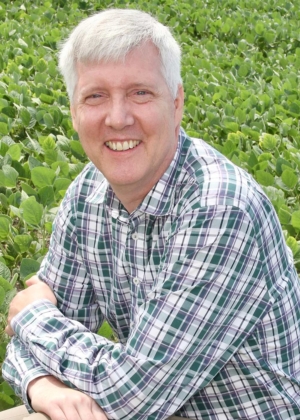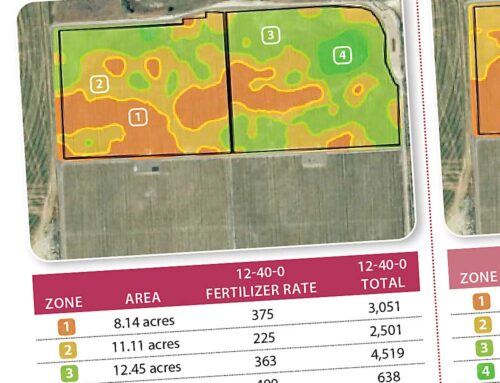An agricultural economist will advise growers where their products fit into the overall food and beverage segment of the economy and culture as the keynote speaker at the 2017 Washington State Tree Fruit Association Annual Meeting and NW Hort Expo.

Michael J. Swanson
Armed with information from a team of specialists in grains, beef, fertilizers and, yes, fruit, Wells Fargo economist Michael Swanson will tell marketers how to win over fickle shoppers, exploit “submarkets” and generally compete for a spot on the American plate — as well as the importance of a story behind a product.
They can successfully do those things if they look “upstream, downstream and sideways” for forces that affect fertilizer, water and pesticides, as well as those that affect hair products, toys and anything else stores sell.
“They really don’t care if they sell apples or if they sell diapers,” he told Good Fruit Grower in a preview of his talk.
Swanson will deliver the annual Batjer Memorial Lecture, named for L.P. “Jack” Batjer, the U.S. Department of Agriculture researcher best known for his work with his blossom and fruit chemical thinning.
The trends
For every dollar generated at the farm and ranch level, agribusinesses and retailers pile on another $4.50 in added value before the consumer purchases it. That ratio is only going to get higher, Swanson said. “They can only eat so many calories per day, but they can spend almost unlimited money on the experience.”
Growers need to focus on creating that experience with new varieties and storytelling.
Swanson, who grew up and now works in Minnesota, has spent 17 years with Wells Fargo, the nation’s largest agricultural lender.
He offers consulting services and is one of the contributors to the Wells Fargo food and agribusiness blog “Food for Thought.”
His wife, Marsella, also is an agricultural economist and sometimes works with him.
Swanson plans to consult with Wells Fargo fruit industry specialists in Portland, Oregon, and California, as well as lending officers in the Yakima, Washington, office.
This will mark his second visit to Washington’s annual meeting following his keynote in 2011. In fact, that’s what made Dan Plath, one of this year’s conference organizers, invite him to speak.
Plath, of Washington Fruit, one of the state’s larger fruit companies, asked Swanson to address questions about the continuing demand for Honeycrisp and organic apples and what the industry can expect in the rollout of the Cosmic Crisp, the new Washington State University variety expected to hit store shelves in 2020.
A sneak peak
Swanson said the price for Honeycrisps — he calls them Moneycrisps — may fall if production keeps going up, but a 15 percent price drop in exchange for selling 200 percent more may be worth it.
And while shoppers may not be willing to eat more, the Honeycrisp story proves they are willing to spend more. They keep asking for higher quality and exclusivity.
Among fruits, strawberries have been gaining plate share at the most rapid rate, Swanson said, and berry giant Driscoll’s controls more than 90 percent of the genetics in producing better strawberries. Apple cultivar developers are more scattered, often at land grant colleges, and can’t move as quickly.
However, that only gives apples a better chance to tell a story and market their fruit much like wine. Thus, growers must gamble on new varieties, including Cosmic Crisp, he said.
“Cosmic Crisp is almost a mandatory industry development,” he said.
Cosmic Crisp is the brand name for WA 38, a variety developed by WSU’s breeding program specifically for Washington growers — suited for the climate and storage infrastructure of the nation’s top apple producing state. The industry has invested nearly $500 million in ramping up production and marketing.
Swanson calls prices for apples somewhat inelastic. Supply often goes up faster than demand drops, such as with the current organic market. Yes, the organic premium will erode as market share grows — it has and will likely continue — but not as fast as the price.
Submarkets play a role, too. Swanson claims that people eat the story as much as they eat the food. Who knows what story might resonate with consumers?
Maybe only 1 million Americans want an apple that was grown, say, only on eastern-facing slopes, but they could constitute a lucrative niche. At the same time, he also sees room for growers purchasing older orchards of Red Delicious trees, seeking to cut costs and survive on lower margins.
“You really don’t need to change the entire market,” he said.
Swanson also will discuss profitability data tracked by the Risk Management Association, a Philadelphia-based nonprofit of loan authorizers. In the 2015-2016 season, apple producers nationwide averaged 4 percent profit, above the long-term average of 3 percent but down from the record of 14.6 percent in 2012-2013. The organization was scheduled to release 2016-2017 data in mid-October, so Swanson will discuss more current figures at the conference.
All industries follow cycles, usually with peaks and valleys about four or five years apart, he said.
Growers can’t do much about that. But they can, he said, try to make sure they are profitable even in down years. Even last season, the most profitable producers showed a 10 percent return on assets while the least had negative returns on assets.
Growers should focus on being one of those profitable producers instead of fretting about what the overall market will do. “How did somebody do that well in that environment?” •
113th Washington State Tree Fruit Association Annual Meeting and Northwest Hort Expo
When: Dec. 4, 5, 6, 2017
Where: Three Rivers Convention Center, Kennewick, Washington
Theme: “Finding Opportunity in Constant Market Changes”
Batjer Memorial Lecture: Michael Swanson, agricultural economist and consultant, Wells Fargo, Minneapolis, Minnesota.
– by Ross Courtney






Leave A Comment